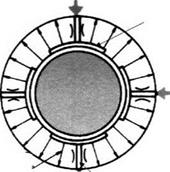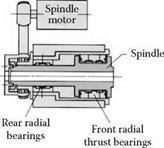For applications demanding the greatest stiffness, damping, and power handling requirements with minimal runout, many machine tool builders choose hydrostatic bearings. A hybrid hydrostatic bearing can provide greater load support than many hydrodynamic bearings of the same diameter and can withstand crashes better than other bearing types; a significant issue when using steel — cored CBN wheels! The other major advantage of hydrostatic bearings is that, when properly tuned,
|
the averaging effect of the bearing will improve running truth by over an order of magnitude relative to the accuracy at which the individual components were machined [Aleyaasin, Whalley, and Ebrahimi 2000]. Radial errors of <0.5 pm throughout the life of the spindle are typical [Aronson 1995]. For this reason, hydrostatics have become common, if not the standard, for applications such as camshafts [Landis 1996a] and crankshafts [Landis 1996b], roll grinding [Elgin n. d., Waldrich Siegen 1996], some centerless grinders [Koyo 2 n. d.], and several standard cylindrical grinders [Paragon n. d.].
Rotary hydrostatic bearings are built in a similar fashion to their linear counterparts with metered fluid under pressure fed to a series of bearing pads. There are usually two radial or journal bearings with four opposed pads in each and either two axial thrust bearings or an axial thrust and additional oil-filled chamber behind the journal bearing and pressurized by it [Montusiewicz and Osyczka 1997].
![]()

![]()

![]()
![]()
 Hydrostatic pressure
Hydrostatic pressure
Hydrodynamic
pressure
 |
FIGURE 15.34 Examples of bearing arrangements for small wheel spindles. (From Danobat 1991. With permission.)
At rest, the bearing is purely hydrostatic but as the spindle rotates, fluid will be dragged into the narrow space between the pads generating additional hydrodynamic pressure. While some drag is inevitable and provides additional support at lower speeds, it can lead to instability and excessive heat at higher speed unless flowrate, pad widths, and depths are selected carefully. The principles of hybrid hydrostatic/hydrodynamic bearings were developed by Rowe [1983] who provided design charts for load-bearing capacity and criteria for stable operation. Recessed and plain hybrid hydrostatic designs have been established [Rowe, Koshal, and Stout 1977, Rowe and Koshal 1980, Rowe et al. 1982, Koshal and Rowe 1980, Ives and Rowe 1987].
Several Japanese machine tool builders design spindles specifically to incorporate the effect into “hybrid” hydrostatic spindles [Toyoda 1996, NTC 1999]. Whereas a pure hydrostatic spindle might need 1,000 psi oil pressure, a hybrid bearing might need only 300 psi for the same stiffness. The disadvantage is that the center of rotation will change with spindle speed and oil viscosity [Aronson 1995].
The major disadvantages of hydrostatic bearings, in general, are in the manufacturing and ancillary equipment requirements and their associated costs. The bearings require an oil pump, collection, and recirculation system with filtration to <5 pm, and a chiller to hold the oil to ambient temperature. Hydrostatic spindles tend to be limited to about 750,000 DN due to heat generated by fluid shear, although bearing temperatures can be kept low by optimization of flowrate to remove unwanted heat [Rowe 1970].

